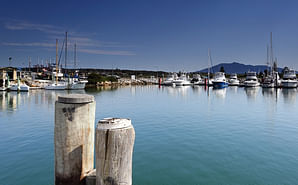Water Quality
Council provides quality drinking water to residents that is regularly tested and complies with Australian guidelines.
Australian Drinking Water Quality Guidelines
The Australian Drinking Water Guidelines 2011 (ADWG) provide a framework for the management of drinking water supplies. They are a reference for what defines safe, good quality water, how it can be achieved and how it can be assured. They are concerned both with safety to human health and with aesthetic quality. Guideline values for microbial, physical and chemical characteristics are provided for water utilities to work towards.
Drinking water quality monitoring program in the Bega Valley Shire
The NSW Health Drinking Water Monitoring Program (DWMP) requires monitoring of water quality at the point of supply and analysis of water samples for their physical, chemical and microbial characteristics. Samples for the program are collected by Council Environmental Health Officers and analysed at the NSW Forensic and Analytical Science Service (FASS) laboratory. The DWMP helps the BVSC to achieve verification of drinking water quality and assess the overall performance of our drinking water management system and the ultimate quality of drinking water being supplied to customers.
In the Bega Valley Shire, drinking water samples are taken from 100 separate sampling locations (taps) throughout the year for microbial analysis across the 4 water supply systems. These water samples are analysed for E.coli and total coliforms. Free chlorine and total chlorine are also analysed at these sites.
Drinking water samples are also taken from 28 separate sampling locations throughout the year for physical and chemical analysis across the 4 water supply systems. These water samples are analysed for pH, turbidity, total dissolved solids, hardness, colour, fluoride, sulphate, nitrate, nitrite, iron, manganese, other metals and heavy metals.
The ADWG framework for the management of drinking water quality also includes a requirement for regular communication with the community about drinking water monitoring results and water quality issues. It is also a requirement under the NSW Public Health Regulation 2022 that BVSC's drinking water quality management system include processes for community engagement and raising community awareness about the quality of drinking water and incidents within our water supply systems.
Our DWMP Water Quality Report 2023-2024 contains a summary of analysis results of water quality monitoring undertaken within each of our water supply systems as part of the DWMP during 2023-2024 and compliance with ADWG guideline values.
PFAS
Per-and poly-fluoroalkyl substances (PFAS) are chemicals used to make products which resist heat, stains, grease and water. PFAS remain in the environment, including water and soil, for a long time. People can be exposed to PFAS through food, water, air and skin contact.
The National Health and Medical Research Council (NHMRC) develops the Australian Drinking Water Guidelines (ADWG), which include health-based guideline values for PFAS in drinking water. These guidelines have recently been reviewed. The NHMRC has confirmed that drinking water, as long as it meets its current drinking water guidelines, remains safe to drink.
Water utilities are responsible for assessing and managing the risk of PFAS in drinking water. NSW Health recommends all water utilities undertake initial testing for PFAS.
In December 2024 Bega Valley Shire Council and NSW Health undertook an initial round of PFAS testing at six sampling locations, one for each treated water source. No PFAS was detected. The results are shown in the table below.
| Site | Barcode | Date Collected |
PFBS |
PFHxS |
PFOA |
PFOS |
Sum of PFOS and PFHxS |
|---|---|---|---|---|---|---|---|
| South Bega Reservoir 2 | A24BV0100001 | 10/12/2024 | <0.001 | <0.001 | <0.001 | <0.001 | <0.001 |
| Boydtown Balance Tank | A24BV0200001 | 10/12/2024 | <0.001 | <0.001 | <0.001 | <0.001 | <0.001 |
| Merimbula Tank 3 | A24BV0300001 | 10/12/2024 | <0.001 | <0.001 | <0.001 | <0.001 | <0.001 |
| Wolumla Reservoir | A24BV0400001 | 10/12/2024 | <0.001 | <0.001 | <0.001 | <0.001 | <0.001 |
| Bemboka Water Treatment Plant CWT | A24BV0500001 | 10/12/2024 | <0.001 | <0.001 | <0.001 | <0.001 | <0.001 |
| Brogo Water Treatment Plant CWT | A24BV0700001 | 10/12/2024 | <0.001 | <0.001 | <0.001 | <0.001 | <0.001 |
The risk of PFAS contamination of drinking water in the Bega Valley Shire is very low. There are no known risk sites within drinking water catchments.
Water quality issues of the Bega Valley Shire
Sampling and analysis of water quality for compliance with the ADWG guideline values shows Bega Valley Shire to have a very high quality of water (refer above). Nevertheless, there are factors and occurrences that detrimentally affect water quality at certain times and for some customers. The main causal factors, water quality issues and systems where these issues arise are shown in the table below.
| Main causal factors affecting water quality | Water quality issues | Water supply systems where this is an issue |
|---|---|---|
| Rainfall run-off in catchment areas | Turbid water with sediment solids enters, settles and accumulates in the water supply network. Solids periodically re-mobilise and increase the water turbidity for some customers. | Tantawanglo-Kiah (north) |
| Dissolved iron and manganese in groundwater | Hydroxides of iron and manganese form, enter, settle and accumulate in the water supply network. Solids periodically re-mobilise and increase the water turbidity for some customers. | Bega-Tathra, Tantawanglo-Kiah (south) |
| Algae in dams | Algae and other organics when chlorinated may impart a musty taste and smell to the water. Some species of blue-green algae are toxic and there is a risk that a toxic species may bloom in the future. | Tantawanglo-Kiah, Brogo-Bermagui |
| Dam turnover | Occurs autumn or winter in some years in Brogo Dam, operated by Water NSW. Turbid, coloured and iron rich water rises from low water levels to the surface. In the weeks following, this water flows downstream to the Brogo-Bermagui system pump intake and into the water treatment plant. | Brogo-Bermagui |
| Soft source water | Soft water is believed to contribute to the corrosion of pipework, including household copper pipes, causing elevated copper levels in the water at some properties. Health advice for copper in drinking water is available in the ADWG (p145, pp525-527) and on the NSW Health web site. | All systems |
| Biofilm growth in pipes | Biofilm growth may impart a musty taste and smell to the water. Biofilm may periodically slough away, causing coloured and turbid water to be experienced by some customers. | All systems |
Water mains and reservoirs on each system need to be cleaned periodically (flushing and vacuuming) to remove sediment (clays, iron hydroxide, carbonates, organic matter). The majority of dirty water issues are due to the re-suspension of sediment that has accumulated within parts of the system. Chlorine residuals can be variable at some locations due to the long detention times in the system.
Water treatment plants
There are currently two water supply systems with water treatment plants in the Bega Valley Shire. The water treatment plant at Brogo filters, chlorinates and fluoridates water from the Brogo River to supply drinking water to customers within the Brogo-Bermagui water supply system. The water treatment plant at Bemboka filters and chlorinates water from the Bemboka River to supply drinking water to customers at Bemboka.
Construction of another treatment plant at Bega is underway, with completion due in early 2025. This plant will filter raw water from the Bega borefield and disinfect it with UV light and chlorine. The treated water will also be fluoridated before being supplied to customers within the Bega-Tathra water supply system.
For water supply systems where there is currently no water treatment plant, water is extracted from the source and disinfected with chlorine. Rechlorination is also undertaken in locations where and when monitoring shows the level of chlorine residual to be lower than required.
Water treatment plants will improve customer levels of service, compliance with ADWG guideline values and enable source and storage water quality risks to be managed more effectively.
Using water in the home
Use water from the cold water tap for drinking and cooking. Hot water systems may contain more dissolved minerals and metals, due to the heating process.
Copper pipes are used extensively in plumbing systems in Australia (and internationally). Drinking water can contain elevated metals such as copper and sometimes lead when left standing in pipes for extended periods. In this case, it is a good idea to flush cold taps for 2-3 minutes before using the water for drinking or cooking. This will lower the levels of copper and other metals that may be present in the water. This ‘first-flush’ of water can be used for washing up, watering plants, or other non-drinking uses.
Fluoridation
The NSW Government considers fluoridation of community water supplies an effective way to deliver fluoride to all members of the community. In the Bega Valley Shire, only the Bega-Tathra water supply system is fluoridated. The other three systems remain non-fluoridated. Any changes to the water supply in the Bega Valley Shire in regard to fluoride will be made with community consultation.






